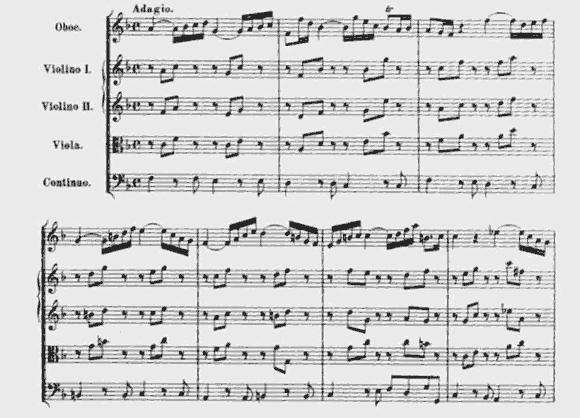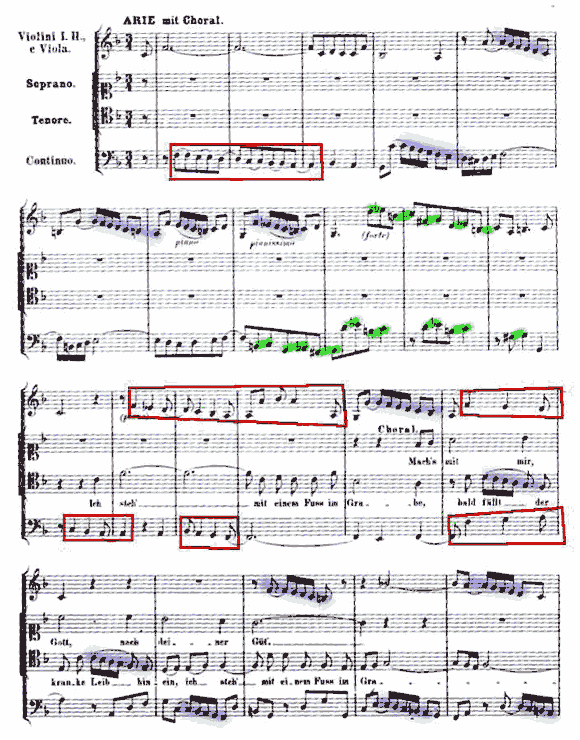Cantata 156 was written for the third Sunday after Epiphany in 1729, and was first performed on January 23 of that year. The text is by Picander, one of Bach’s favorite librettists. of the four cantatas written by Bach for the feast (72, 73, 111, and 156), it was the last, and the only one scored for solo voice. Like Cantatas 73 and 111, it is a chorale cantata, employing a chorale melody in several movements. Cantata 156, in fact, employs two different chorale tunes and texts in the second and sixth (final) movements, respectively; the seconds uses “Machs mit mir, Gott, nach deiner Güt” (Schein, 1628), which “Herr, wie du willt, so schicks mit mir” (Binemann, 1582) is reserved for the finale.
The entire cantata is summarized in the chart below.
| Movt | Key | Meter | Tempo | Scoring | Notes |
| 1 | F major | 4/4 | Adagio | solo oboe, strings, continuo | sinfonia |
| 2 | F major | 3/4 | Moderately slow | violins and violas in unison, solo soprano, solo tenor, continuo | Aria with chorale |
| 3 | D minor | 4/4 | Free | solo bass, continuo | simple recitative |
| 4 | B-flat major | 4/4 | Moderate | Solo oboe, violins (possibly solo alto, continuo) | aria |
| 5 | G minor to A minor |
4/4 | Free | Solo bass, continuo | Simple recitative |
| 6 | C major | 4/4 | Moderate | SATB voices doubled by instruments | 4-part chorale |
Eric Chafe describes Cantata 156 as being one of two cantatas (the other is 27) which begins with anticipation of death. Cantata 156 serves as the “prayer of one near death for release from the sickbed of punishment for sin, then for God’s aid with the sickness of the soul.” The cantata begins in F major and ultimately moves to C major, after first moving downward from F to d minor to B-flat major. Clearly, the descent represents the sickness moving towards death, while we might view the resolution to C major might be a positive resolution, as man surrenders himself over to God’s grace.
The first movement, a sinfonia, uses material that belonged to a “hypothetical oboe concerto” (BWV 1059). (Werner Breig, Cambridge Companion to Bach). Schulenberg notes that this movement was later arranged by Bach as the slow movement of the F minor Harpsichord Concerto. In the cantata version, the solo part is less ornamented than in the surviving harpsichord version. The ending is also different, leading here directly into the subsequent movement. It has for me a very pastoral feeling, one I often associate with the Christmas season. (Think of the final pastorale of Corelli’s Concerto Grosso in G minor, the so-called “Christmas Concerto”, or the pastorale from Handel’s Messiah.) The slow tempo (here, marked “adagio”) and F major key contribute significantly to this feeling.

The next movement begins unusually. Though it is clear from the string melody where the beat falls, the continuo enters with a syncopated descending line that is unsettling initially; although moments of syncopation (marked in blue) emerge at other times in the violin line or in the continuo line, they are brief, and this does not become the dominant idea in the movement. That, in fact, would be the many descending sixteenth-note passages (marked in red) that we hear in the violins, continuo, and even in the solo tenor line. But the initial syncopation is so disquieting and so prominent, I cannot help but think that there is some significance to it. Does it represent the struggle against certain death, or at the very least man’s physical struggle against his bodily illness? Is it the struggle between the physical and spiritual worlds? In addition to the rhythmic instability, Bach creates moments of tonal instability with chromatic lower neighboring tone ideas (marked in green).

In any event, four distinct and independent ideas (violin melody, active continuo, tenor solo, and chorale melody) are merged by Bach in this movement into one, creating a complicated texture, a sort of chorale fantasia, which might we might expect for the first vocal movement in a chorale-based cantata.
The next section of this movement introduces a new text, while keeping the same polyphonic texture. The descending sixteenth-note motive is also retained here. Picander’s text becomes a prayer to God, that God’s will be done to help the singer to his end. The music, while sounding familiar because of the repeated ideas, is new, using sequences and repeated text to make a more convincing plea to God.
After a somewhat anguished bass recitative, the solo oboe returns to soften the sound of the subsequent aria. Here, the violin and solo oboe play complementary roles, often playing in parallel thirds or sixths while the solo alto sings again of God’s will. You will note that many repetitions of the text “herr, was du willst” – which we also hear in Cantata 73 – but which might be seen as an important tenet of Lutheran belief. We find, in addition, some nice examples of word painting in this movement, most notably:
- lengthy, active melismas on the word “Freuden” (joy)
- a slowing of the rhythms on “Sterben” (death)
- in the use of diminished chords and minor sounds on “Leide” (sadness)


































